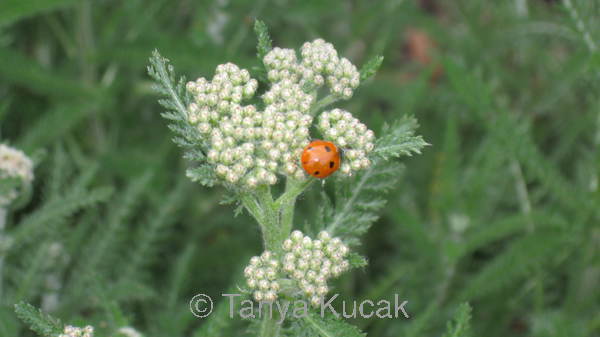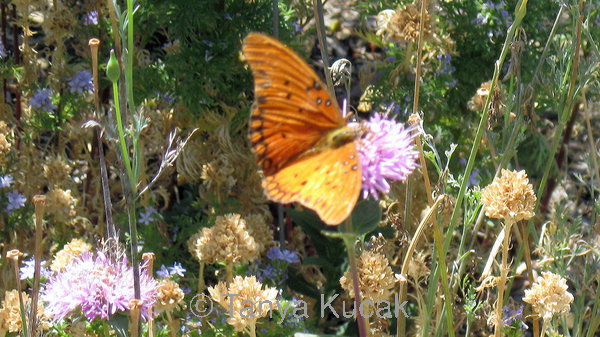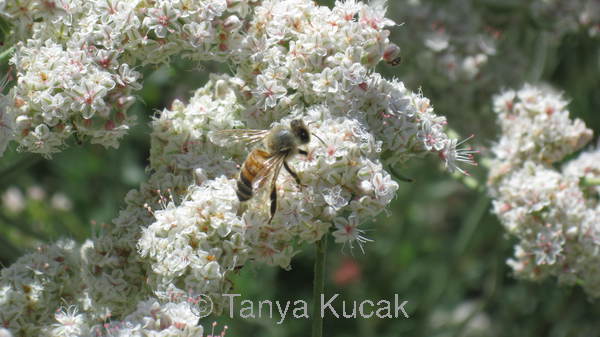
Lions and tigers and bears are the charismatic megafauna of the larger world. In the garden, the charismatic megafauna of the insect world are butterflies and dragonflies.
Spotting butterflies and dragonflies feels like a gift, but the more time I spend in the garden, the more I appreciate all insects.
Insects are the engines that make a garden ecosystem work. Their crucial roles include pollination, waste disposal, and seed dispersal. I've observed that plant-eating insects often prey on the weakest plants, and beneficial insects keep the plant-eating insects in check. Birds are attracted to the insect buffet of a healthy garden.
If you're interested in creating or improving a garden that welcomes wildlife, get a copy of Nancy Bauer's new book, The California Wildlife Habitat Garden: How to Attract Bees, Butterflies, Birds, and Other Animals (UC Press, 2012).
Abundantly illustrated with color photos, the book has five chapters that focus on the basics of a wildlife garden, bird habitat, butterfly gardens, pond gardens, and front-yard habitat gardens. Up to half of each chapter consists of one or more garden profiles. The garden profiles bring the art of habitat design down to earth, with details such as using sand-filled burlap bags to create steps in a pond. Bauer relates each gardener's story of why they started their garden, how it has changed over time, what successful elements it contains, and what wildlife they've observed. An annotated plant list for each garden notes which ones are native and describes who visits them or how they're used.
If you've participated in native garden tours or seminars in the Bay Area, you may recognize some of the featured gardens and gardeners.
Sidebars sprinkled through the book cover special topics such as a screened treeway for house cats to observe birds, what makes a useful nest box for birds, sheet mulching to convert a lawn to a habitat garden, and plant combinations for pots.
Though Pacific Chorus frogs are featured in the chapter on wildlife ponds, other amphibians and reptiles are mentioned only briefly. Notably, ticks that bite the Western Fence lizard are purged of any Lyme disease bacteria hiding in their gut, which may be why Lyme disease is less prevalent in the West.
This is a book about how to attract wildlife you want, not about how to exclude wildlife you don't want. So although Bauer mentions deer-resistant plants, she does not cover the topic in depth. Nor does she discuss gophers, squirrels, raccoons, or roof rats, except to suggest container plantings to foil gophers. That's partly because of the mindset of some of the wildlife gardeners she interviews. For instance, Kathy Biggs bestows ownership of the pond to her wildlife, including fox families and raccoons, whom she calls the great re-arrangers.
The final quarter of the book is devoted to ten appendices with summaries of practical information, including natural gardening guidelines and resource lists (books and nurseries). The plant lists are annotated and offer seasonal plants for hummingbirds, common California butterflies and their host plants, what to plant in hedgerows and under oaks, and top nectar and pollen plant families.
The book could be even more useful if its index covered more than plant names, but that won't stop me from recommending it.

Ladybugs are drawn to yarrow. Two days after I noticed ladybugs on my yarrow plants this spring, all the aphids that had furred the leaves and buds of my kale plants were gone. Ladybug larvae have a voracious appetite for aphids, and it's worth ignoring a large aphid population in the spring so that the beneficial insects can feast.

A Gulf Fritillary butterfly sips nectar from a native coyote mint flower. Gulf Fritillaries are common in the Bay Area, though they are not natives. They lay their eggs on passion flower vines.

Bumblebees enjoy visiting coyote mint. Native bumblebees live in small colonies in the ground. To keep them in your garden, leave a small patch of bare, unmulched soil in your garden .

Native buckwheats attract numerous pollinators and other beneficial insects, including honeybees. Look closely at the tiny flowers of any native buckwheat, and you may spot tiny beneficial insects.
© 2013 Tanya Kucak